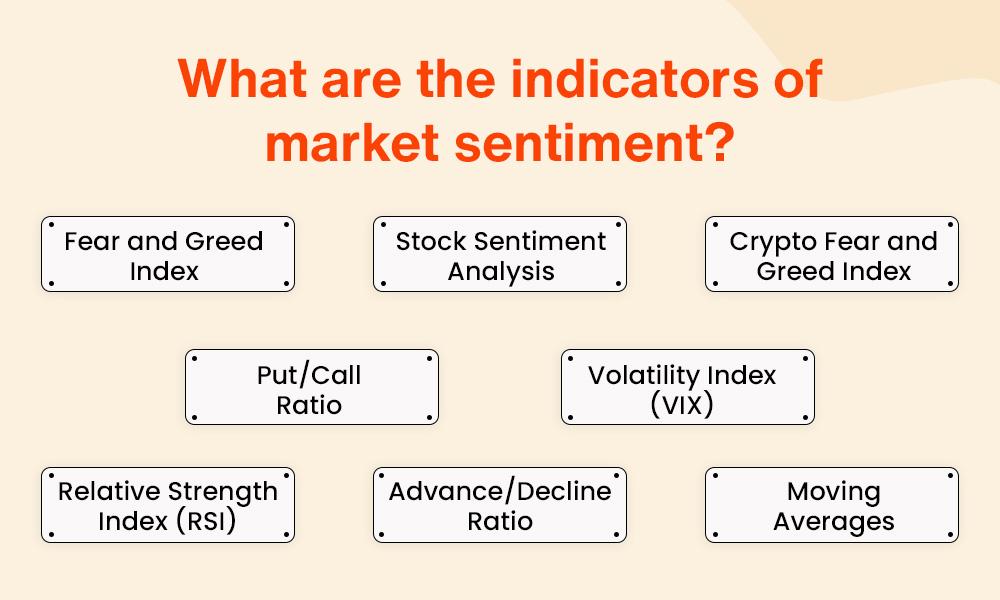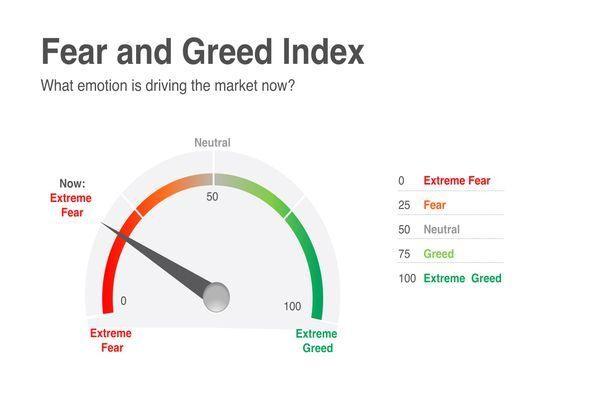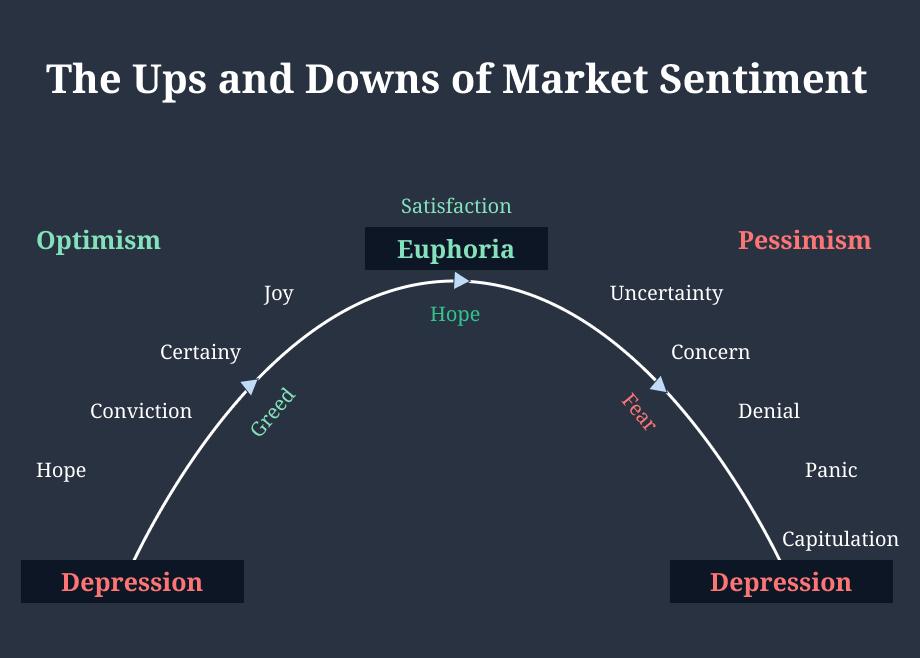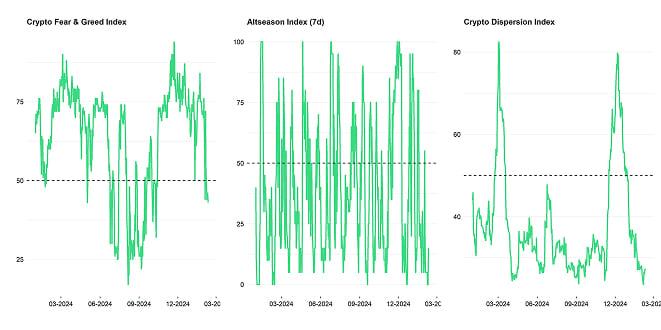In the ever-evolving world of cryptocurrency, where fortunes can shift with the blink of an eye, understanding the mood of the market is more crucial than ever. Crypto market sentiment indicators serve as the compass for traders and investors navigating these turbulent digital seas. These tools distill the collective emotions, hopes, and fears of the market into actionable insights, helping to illuminate trends that might otherwise remain hidden. Whether you’re a seasoned trader or a curious newcomer, grasping these indicators can be the key to making informed decisions in a landscape defined by volatility and opportunity. Let’s delve into the essential sentiment indicators that every crypto enthusiast should know.
Table of Contents
- Understanding the Role of Sentiment Indicators in Crypto Trading
- Key Sentiment Metrics and How to Interpret Them
- Leveraging Social Media and News Sentiment for Market Insights
- Integrating Sentiment Indicators with Technical Analysis for Better Decisions
- Practical Tips for Using Sentiment Data to Manage Risks and Maximize Gains
- Frequently Asked Questions
- To Wrap It Up

Understanding the Role of Sentiment Indicators in Crypto Trading
In the fast-paced world of cryptocurrency, understanding market sentiment is crucial for making informed decisions. Sentiment indicators serve as a compass, helping traders gauge the emotional climate around specific assets or the market as a whole. These tools analyze a mix of data-from social media chatter to trading volumes-to reveal whether optimism or fear predominates, often signaling potential price movements before traditional indicators catch up.
Among the most widely used sentiment tools are the Fear & Greed Index, which distills complex market emotions into an easy-to-understand score, and social sentiment analysis, which scours platforms like Twitter and Reddit for trending topics and community mood. These indicators provide a snapshot of traders’ collective psychology, offering clues about possible rallies or sell-offs. By integrating these insights, savvy traders can better time their entries and exits, potentially minimizing risk and maximizing gains.
It’s important to remember that sentiment indicators are not standalone predictors but rather pieces of a larger puzzle. Combining sentiment data with technical analysis and fundamental research creates a more balanced trading strategy. For example, a sudden spike in positive sentiment might coincide with a technical breakout, reinforcing the trade’s potential. Conversely, a misleading sentiment surge could signal a temporary hype bubble, prompting caution.
- Volume-Weighted Sentiment: Tracks how much trading volume supports positive or negative sentiment.
- On-Chain Metrics: Examines blockchain activity like wallet transactions to gauge real investor behavior.
- News Sentiment Scores: Uses AI to assess the tone of crypto-related news articles and headlines.
| Indicator | What It Measures | Typical Use |
|---|---|---|
| Fear & Greed Index | Market emotions from fear to greed | Identify overbought or oversold conditions |
| Social Sentiment | Community mood from social media | Spot trending coins and hype cycles |
| On-Chain Metrics | Blockchain transaction data | Confirm investor activity and confidence |
Key Sentiment Metrics and How to Interpret Them
Understanding the mood of the crypto market often boils down to analyzing a handful of vital indicators that reveal traders’ collective psychology. One of the most commonly referenced metrics is the Fear & Greed Index. This gauge aggregates data from volatility, market momentum, social media trends, and surveys to assign a score ranging from extreme fear to extreme greed. When fear dominates, it usually signals undervaluation and potential buying opportunities, whereas greed hints at overbought conditions prone to corrections.
Another crucial metric is social sentiment analysis, which mines data from Twitter, Reddit, Telegram, and other platforms to quantify positive or negative chatter around specific coins or the market overall. High volumes of positive sentiment can sometimes precede price surges, but beware of overly bullish hype that can lead to sudden reversals. Conversely, an overwhelming negative tone might suggest a market bottom is near.
Let’s not overlook the whale activity indicator. Tracking large transactions by major holders reveals shifts in confidence among influential market players. Sudden spikes in whale buying might indicate accumulation phases, while large-scale sells can foreshadow downturns. Monitoring this alongside volume trends offers deeper insight into market dynamics.
| Metric | What It Shows | Interpretation |
|---|---|---|
| Fear & Greed Index | Overall market emotion | Extreme fear = buying opportunity; extreme greed = caution |
| Social Sentiment | Public opinion and hype levels | Positive buzz = potential rally; negative buzz = possible bottom |
| Whale Activity | Large holder transactions | Spike in buys = accumulation; spike in sells = warning sign |
- Combine metrics for a holistic view rather than relying on one indicator alone.
- Context is key: Market cycles and external events can heavily influence sentiment readings.
- Stay objective: Sentiment tools are guides, not guarantees-always apply sound risk management.

Leveraging Social Media and News Sentiment for Market Insights
In today’s fast-evolving crypto landscape, understanding the pulse of the market goes beyond traditional charts and technical analysis. Investors increasingly turn to social media trends and news sentiment as critical indicators that can hint at future price movements. Platforms like Twitter, Reddit, and Telegram buzz with real-time chatter from traders and enthusiasts, offering a dynamic view of market psychology that numbers alone can’t capture.
Analyzing this vast sea of data requires sophisticated tools that aggregate and interpret sentiment signals. These tools harness natural language processing (NLP) algorithms to classify posts as bullish, bearish, or neutral, providing a quantifiable sentiment score. For instance, a sudden surge in positive tweets about a particular coin can precede a price rally, while a wave of negative news articles might foreshadow a downturn. This fusion of qualitative and quantitative data forms a new frontier for market insight.
Here are some key elements to watch when leveraging social media and news sentiment:
- Volume of Mentions: A spike can indicate growing interest or emerging hype.
- Sentiment Polarity: The balance of positive vs. negative mentions shapes the overall market mood.
- Influencer Impact: Tweets or posts from prominent figures often sway market reactions significantly.
- News Timeliness: Breaking news can trigger immediate sentiment shifts, especially regulatory updates or partnerships.
| Sentiment Indicator | Description | Market Signal |
|---|---|---|
| Social Volume | Number of mentions on social media platforms | High volume may indicate an upcoming trend |
| News Sentiment Score | Aggregated positivity or negativity of news articles | Negative scores often precede dips |
| Influencer Activity | Engagement from key opinion leaders | Can trigger rapid price swings |

Integrating Sentiment Indicators with Technical Analysis for Better Decisions
Combining sentiment indicators with traditional technical analysis tools opens a new dimension in understanding crypto market dynamics. While technical analysis focuses on price patterns, volume, and momentum, sentiment indicators reveal the underlying emotional state of traders, which often drives market volatility. Together, they create a more comprehensive view that can help anticipate potential price movements before they fully materialize.
Why does this integration matter? Technical signals can sometimes be misleading when market sentiment is overwhelmingly positive or negative. For example, a bullish chart pattern may fail if the overall sentiment is fear-driven, causing traders to exit prematurely. Conversely, a bearish setup might be defied by strong optimism among investors. By layering sentiment data, you gain context that tempers technical signals with real-time crowd psychology.
- Sentiment extremes: Identify when the market is overly optimistic or pessimistic to spot potential reversals.
- Volume versus sentiment: Confirm if high trading volume aligns with positive or negative sentiment to validate trends.
- Social media buzz: Track real-time conversations that can foreshadow sudden price surges or drops.
| Technical Indicator | Sentiment Indicator | Combined Insight |
|---|---|---|
| RSI (Relative Strength Index) | Fear & Greed Index | Detects overbought conditions tempered by market fear to avoid false breakouts. |
| Moving Averages | Twitter Sentiment Score | Confirms trend strength when positive sentiment aligns with bullish crossovers. |
| MACD (Moving Average Convergence Divergence) | Reddit Activity Levels | Signals momentum shifts validated by changes in community engagement. |
Practical Tips for Using Sentiment Data to Manage Risks and Maximize Gains
Understanding how to interpret sentiment data can transform the way you approach crypto trading. One effective strategy is to combine sentiment indicators with technical analysis. For example, if the market sentiment shows extreme optimism but the price is hitting resistance levels, it might signal an impending correction. Conversely, negative sentiment during a price dip could be a buying opportunity if supported by strong fundamentals.
Another practical tip is to monitor sentiment divergence. This occurs when price trends and sentiment indicators move in opposite directions, often hinting at a potential reversal. By keeping an eye on social media trends, news sentiment, and on-chain data, you can anticipate shifts before they become obvious in price charts.
Risk management becomes more intuitive when sentiment data is factored into your decision-making. Setting stop-loss levels in alignment with sentiment extremes-such as during euphoric rallies or panic sell-offs-can help protect your capital. Additionally, use sentiment to calibrate your position sizes; smaller stakes during uncertain or highly volatile sentiment periods reduce exposure.
- Cross-verify sentiment signals with volume and volatility metrics
- Track sentiment over different time frames for better context
- Use sentiment heatmaps to identify market mood pockets
| Sentiment Signal | Possible Market Implication | Recommended Action |
|---|---|---|
| Extreme Optimism | Overbought conditions | Consider profit-taking or tightening stops |
| High Fear Index | Potential market bottom | Look for buying opportunities |
| Sentiment Divergence | Likely trend reversal | Prepare to adjust positions accordingly |
Frequently Asked Questions
Q&A: Crypto Market Sentiment Indicators You Should Know
Q1: What are crypto market sentiment indicators?
A1: Crypto market sentiment indicators are tools that gauge the overall mood or attitude of traders and investors toward the cryptocurrency market. They analyze data such as social media trends, trading volumes, and price movements to reveal whether the market leans bullish, bearish, or neutral.
Q2: Why should I care about sentiment indicators in crypto trading?
A2: Unlike traditional assets, cryptocurrencies are highly influenced by emotions and hype. Sentiment indicators help you understand the collective psychology driving price action, potentially allowing you to anticipate market turns and make more informed decisions.
Q3: What are some popular crypto sentiment indicators?
A3: Some widely used sentiment indicators include the Fear & Greed Index, social media sentiment analysis, on-chain metrics like whale activity, and trading volume spikes. Each provides a unique lens on market psychology.
Q4: How does the Fear & Greed Index work?
A4: The Fear & Greed Index measures market emotion by combining data points such as volatility, momentum, social media trends, and market dominance. A low score indicates fear (potentially a buying opportunity), and a high score signals greed (possibly a warning for overbought conditions).
Q5: Can social media truly affect crypto prices?
A5: Absolutely. Crypto markets are notoriously sentiment-driven, and platforms like Twitter, Reddit, and Telegram can spark rapid price moves. Sentiment analysis tools scan these channels to detect shifts in investor mood, which often precede price changes.
Q6: What role do ‘whales’ play in market sentiment?
A6: Whales-large holders of cryptocurrency-can sway market sentiment through their trading actions. On-chain indicators track whale transactions to spot accumulation or distribution phases, offering clues about future market trends.
Q7: Are sentiment indicators foolproof?
A7: No indicator is perfect. Sentiment tools provide valuable context but should be used alongside fundamental and technical analysis. Markets can remain irrational longer than expected, so combining multiple strategies is key.
Q8: How can beginners start using sentiment indicators?
A8: Start simple-follow the Fear & Greed Index daily and observe social media sentiment trends. Gradually incorporate on-chain data and volume analysis as you become comfortable. Always cross-check signals before making decisions.
Q9: What’s the takeaway on using sentiment indicators in crypto?
A9: Sentiment indicators shine a light on the emotional undercurrents that drive crypto markets. When used wisely, they can enhance your trading toolkit, helping you navigate the wild waves of this volatile asset class with greater confidence.
To Wrap It Up
As the crypto landscape continues to evolve with dizzying speed, understanding market sentiment indicators can be your compass amid the chaos. These tools offer more than just numbers-they provide a glimpse into the collective mindset of traders and investors, illuminating patterns that might otherwise remain hidden. By integrating sentiment analysis into your strategy, you’re not just reacting to the market; you’re anticipating its moves. Whether you’re a seasoned hodler or a curious newcomer, mastering these indicators can transform uncertainty into informed decision-making. In the ever-shifting world of crypto, sentiment is a language worth learning-and now, you have the key.

